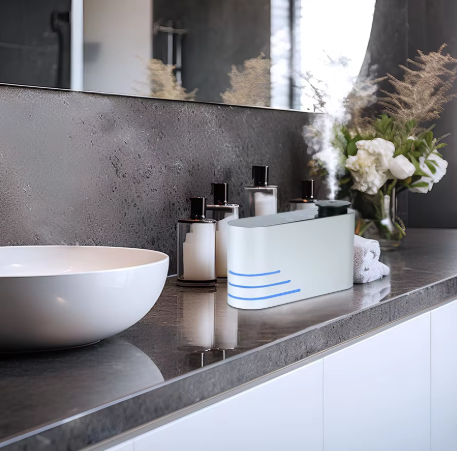ความเข้าใจ น้ํามันอีเซนียล การเลือกขนาดของเครื่องกระจายกลิ่นหอมระเหยให้เหมาะกับประเภทห้องที่แตกต่างกัน
การเลือกที่เหมาะสม เครื่องกระจายกลิ่นในบ้าน สามารถส่งผลอย่างมากต่อประสิทธิภาพการกระจายกลิ่นน้ำมันหอมระเหยในพื้นที่ของคุณ ไม่ว่าคุณจะต้องการสร้างบรรยากาศหอมสดชื่นผ่อนคลายในห้องนอนหลัก หรือเติมเต็มพื้นที่นั่งเล่นแบบเปิดโล่งที่มีพื้นที่กว้างด้วยกลิ่นหอมที่น่าพึงพอใจ การเลือกความจุของเครื่องกระจายกลิ่นที่เหมาะสมจึงมีความสำคัญอย่างมาก ต่อประสิทธิภาพการใช้งานและความพึงพอใจ
ประสิทธิภาพของเครื่องกระจายกลิ่นแบบตั้งโต๊ะขึ้นอยู่กับการเลือกขนาดให้เหมาะสมกับพื้นที่ใช้งานเป็นสำคัญ หากเลือกเครื่องที่มีกำลังต่ำเกินไปจะไม่สามารถกระจายกลิ่นได้ทั่วถึง ในขณะที่เครื่องที่ใหญ่เกินไปอาจทำให้กลิ่นรุนแรงเกินความต้องการ มาดูหลักการเลือกขนาดเครื่องกระจายกลิ่นให้เหมาะสมกับแต่ละห้องภายในบ้านอย่างมีประสิทธิภาพ
ปัจจัยสำคัญในการกำหนดขนาดเครื่องกระจายกลิ่น
มิติของห้องและการคำนวณพื้นที่ใช้งาน
ปัจจัยหลักในการเลือกขนาดเครื่องกระจายกลิ่นคือพื้นที่ของห้องที่ต้องการใช้งาน เพื่อให้ได้ผลลัพธ์ที่ดีที่สุด ควรคำนวณพื้นที่ของห้องโดยการนำความยาวคูณด้วยความกว้าง ห้องนอนขนาดเล็กมาตรฐานมีพื้นที่ประมาณ 120-150 ตารางฟุต ในขณะที่พื้นที่ใช้สอยแบบเปิดโล่งอาจมีขนาดเกิน 400 ตารางฟุต ผู้ผลิตส่วนใหญ่จะกำหนดคำแนะนำในการใช้งานตามข้อมูลขนาดพื้นที่เหล่านี้
โดยทั่วไป สำหรับพื้นที่ทุก 100 ตารางฟุต คุณควรมีดิฟฟิวเซอร์ที่มีความจุอย่างน้อย 100 มิลลิลิตร ซึ่งหมายความว่าห้องนอนเล็กๆ อาจต้องการดิฟฟิวเซอร์ขนาด 150 มิลลิลิตร เท่านั้น ในขณะที่พื้นที่นั่งเล่นแบบเปิดโล่งอาจต้องการหน่วยขนาด 400 มิลลิลิตรหรือใหญ่กว่าเพื่อแจกจ่ายน้ำมันหอมระเหยให้ทั่วถึง
ความสูงของเพดานและรูปแบบการไหลเวียนของอากาศ
ความสูงของห้องมีผลอย่างมากต่อการกระจายของกลิ่นหอม พื้นที่ที่มีเพดานสูงต้องการดิฟฟิวเซอร์ที่มีกำลังแรงกว่า เนื่องจากน้ำหอมจำเป็นต้องเติมอากาศในปริมาณที่มากขึ้น ในห้องที่มีเพดานมาตรฐานสูง 8 ฟุต ดิฟฟิวเซอร์ขนาดปกติก็อาจเพียงพอแล้ว แต่ห้องที่มีเพดานลาดหรือพื้นที่สองชั้นจะต้องการหน่วยที่มีกำลังสูงกว่าและมีความจุมากกว่า
ควรพิจารณาถึงรูปแบบการไหลเวียนของอากาศในพื้นที่ของคุณด้วย ห้องที่มีระบบระบายอากาศใช้งาน ผู้คนสัญจรไปมาบ่อย หรือมีทางเข้าออกเปิดโล่ง อาจต้องการดิฟฟิวเซอร์ที่มีกำลังแรงกว่า เพื่อรักษาความเข้มข้นของกลิ่นหอมให้สม่ำเสมอ ระบบปรับอากาศหรือช่องลมสำหรับทำความร้อนสามารถส่งผลต่อการหมุนเวียนของกลิ่นหอม ซึ่งอาจจำเป็นต้องมีการปรับขนาดของดิฟฟิวเซอร์ที่เลือกใช้
ข้อกำหนดเฉพาะเกี่ยวกับขนาดสำหรับพื้นที่ต่าง ๆ
ข้อกำหนดของห้องนั่งเล่นแบบเปิดโล่ง
พื้นที่แบบเปิดโล่งมีความท้าทายเฉพาะสำหรับการเลือกขนาดเครื่องกระจายกลิ่น พื้นที่ประเภทนี้โดยทั่วไปต้องการเครื่องที่มีขนาดใหญ่กว่า โดยมีความจุตั้งแต่ 300 มล. ถึง 600 มล. ขึ้นอยู่กับพื้นที่ใช้สอยทั้งหมด ควรเลือกเครื่องที่มีโหมดปรับความเข้มของฝอยน้ำหอมได้หลายระดับ และมีระยะเวลาในการทำงานที่ยาวนาน เพื่อรักษาความเข้มข้นของกลิ่นให้สม่ำเสมอตลอดทั้งวัน
การวางตำแหน่งเครื่องกระจายกลิ่นอย่างมีกลยุทธ์มีความสำคัญอย่างยิ่งในพื้นที่แบบเปิดโล่ง หากพื้นที่ของคุณมีขนาดมากกว่า 800 ตารางฟุต ควรพิจารณาใช้เครื่องกระจายกลิ่นขนาดเล็กหลายเครื่องแทนที่จะใช้เครื่องเดียวขนาดใหญ่ การจัดวางแบบนี้จะช่วยให้กลิ่นกระจายตัวได้อย่างทั่วถึง และสามารถสร้างโซนกลิ่นที่แตกต่างกันได้ภายในพื้นที่เปิดโล่งเดียวกัน
ข้อกำหนดของเครื่องกระจายกลิ่นสำหรับห้องนอน
ห้องนอนขนาดเล็กมักต้องการเครื่องกระจายความชื้นในบ้านที่มีขนาดเล็กกว่า โดยทั่วไปมีความจุระหว่าง 100 มิลลิลิตร ถึง 200 มิลลิลิตร หน่วยขนาดกะทัดรัดเหล่านี้ให้การปกคลุมที่เพียงพอโดยไม่ทำให้พื้นที่เล็กๆ อึดอัด สำหรับห้องนอนใหญ่ คุณอาจต้องเลือกใช้เครื่องกระจายความชื้นขนาด 250-300 มิลลิลิตร โดยเฉพาะหากห้องนั้นมีพื้นที่นั่งเล่นหรือห้องน้ำในตัว
พิจารณานานการใช้งานเมื่อเลือกเครื่องกระจายความชื้นสำหรับห้องนอน หน่วยที่ใช้งานได้ 6-8 ชั่วโมง เหมาะสำหรับการใช้ตลอดทั้งคืน ในขณะที่เครื่องที่มีโหมดการทำงานแบบไม่ต่อเนื่องสามารถช่วยประหยัดน้ำมันหอมระเหยไว้ในขณะที่ยังคงระดับกลิ่นหอมที่น่าพอใจ

คุณสมบัติขั้นสูงและข้อพิจารณาทางเทคโนโลยี
เทคโนโลยีเครื่องกระจายความชื้นอัจฉริยะ
เครื่องกระจายความชื้นในบ้านแบบทันสมัยมักมาพร้อมกับคุณสมบัติอัจฉริยะที่ช่วยเพิ่มประสิทธิภาพการใช้งานไม่ว่าจะเป็นขนาดใดก็ตาม มองหาหน่วยที่มีเซ็นเซอร์วัดความชื้นในตัวที่ปรับการกระจายความชื้นตามสภาพห้อง แบบขั้นสูงบางรุ่นยังสามารถเชื่อมต่อกับแอปพลิเคชันบนสมาร์ทโฟน ช่วยให้คุณควบคุมและตั้งเวลาความเข้มข้นของการกระจายความชื้นจากระยะไกลได้
ตัวจับเวลาแบบตั้งโปรแกรมได้และโหมดสเปรย์หลายระดับ ช่วยให้คุณปรับแต่งประสบการณ์การใช้งานเครื่องกระจายความชื้นให้เหมาะกับขนาดห้องและความชอบส่วนตัว คุณสมบัติเหล่านี้มีความสำคัญอย่างยิ่งในพื้นที่ขนาดใหญ่ที่การรักษาระดับความหอมให้สม่ำเสมอเป็นเรื่องยาก
ประสิทธิภาพในการครอบคลุมพื้นที่และการตั้งค่าเวลาในการใช้งาน
ความสัมพันธ์ระหว่างขนาดของเครื่องกระจายความชื้นกับระยะเวลาในการใช้งานมีความสำคัญอย่างมากในการรักษาระดับความหอมให้สม่ำเสมอ โดยทั่วไปแล้วเครื่องที่มีความจุมากกว่าจะสามารถใช้งานได้นานขึ้น ซึ่งเป็นประโยชน์อย่างมากในพื้นที่เปิดที่ต้องการการใช้งานอย่างต่อเนื่อง ควรพิจารณาว่าโหมดสเปรย์แต่ละแบบมีผลต่อพื้นที่ที่ครอบคลุมอย่างไร และปรับตั้งค่าให้เหมาะสมเพื่อประสิทธิภาพสูงสุด
เครื่องพ่นละอองน้ำสำหรับใช้ในบ้านบางรุ่นใช้เทคโนโลยีอัลตราโซนิกที่สร้างละอองน้ำที่ละเอียดกว่า ช่วยให้กระจายกลิ่นได้ดีขึ้นแม้ในพื้นที่ขนาดใหญ่ ซึ่งอาจหมายความว่าเครื่องที่มีความจุน้อยกว่าเล็กน้อยแต่มีเทคโนโลยีที่เหนือกว่าอาจมีประสิทธิภาพเหนือกว่าเครื่องรุ่นพื้นฐานที่มีขนาดใหญ่กว่า
คำถามที่พบบ่อย
ฉันจะทราบได้อย่างไรว่าเครื่องกระจายความชื้นบ้านของฉันมีขนาดเล็กเกินไปสำหรับพื้นที่ของฉัน
หากคุณสังเกตว่ากลิ่นหอมมีการกระจายตัวอ่อน กลิ่นไม่ทั่วถึงในทุกพื้นที่ หรือต้องเติมน้ำมันหอมระเหยบ่อยครั้ง อาการเหล่านี้แสดงว่าอุปกรณ์ของคุณอาจมีขนาดเล็กเกินไปสำหรับห้องนั้น คุณควรสังเกตด้วยว่ากลิ่นจางหายไปอย่างรวดเร็วหรือไม่สามารถกระจายไปยังพื้นที่ต่างๆ ได้ครบถ้วนหรือไม่
ฉันสามารถใช้เครื่องฟอกอากาศขนาดใหญ่ในห้องเล็กได้ไหม
แม้ว่าจะสามารถใช้เครื่องกระจายกลิ่นขนาดใหญ่ในห้องเล็กได้ แต่ไม่แนะนำ เนื่องจากอาจทำให้กลิ่นหอมรุนแรงเกินไป หากคุณมีเครื่องกระจายกลิ่นขนาดใหญ่อยู่แล้ว ควรใช้ในระดับต่ำสุด และพิจารณาเปิดใช้งานเป็นระยะเวลาสั้นๆ เพื่อป้องกันไม่ให้กลิ่นหอมเข้มข้นเกินไป
การวางเครื่องกระจายกลิ่นในพื้นที่แบบเปิดโล่งอย่างไรจึงจะเหมาะสมที่สุด
เพื่อให้การกระจายกลิ่นหอมมีประสิทธิภาพสูงสุดในพื้นที่เปิดโล่ง ควรตั้งเครื่องกระจายกลิ่นไว้ในตำแหน่งศูนย์กลาง และอยู่ห่างจากแหล่งลมโดยตรง เช่น ช่องลมหรือพัดลม ควรวางอุปกรณ์ให้สูงจากพื้นเล็กน้อย และตรวจสอบให้แน่ใจว่ามีพื้นที่ว่างรอบๆ อย่างน้อยสองฟุต เพื่อให้เกิดการกระจายฝอยละอองได้อย่างเหมาะสม

